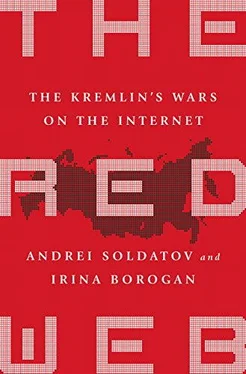Андрей Солдатов - The Red Web - The Struggle Between Russia's Digital Dictators and the New Online Revolutionaries
Здесь есть возможность читать онлайн «Андрей Солдатов - The Red Web - The Struggle Between Russia's Digital Dictators and the New Online Revolutionaries» весь текст электронной книги совершенно бесплатно (целиком полную версию без сокращений). В некоторых случаях можно слушать аудио, скачать через торрент в формате fb2 и присутствует краткое содержание. Город: New York, Год выпуска: 2017, ISBN: 2017, Издательство: PublicAffairs, Жанр: История, Политика, Интернет, Публицистика, на английском языке. Описание произведения, (предисловие) а так же отзывы посетителей доступны на портале библиотеки ЛибКат.
- Название:The Red Web: The Struggle Between Russia's Digital Dictators and the New Online Revolutionaries
- Автор:
- Издательство:PublicAffairs
- Жанр:
- Год:2017
- Город:New York
- ISBN:978-1-61039-57-3-1
- Рейтинг книги:3 / 5. Голосов: 1
-
Избранное:Добавить в избранное
- Отзывы:
-
Ваша оценка:
- 60
- 1
- 2
- 3
- 4
- 5
The Red Web: The Struggle Between Russia's Digital Dictators and the New Online Revolutionaries: краткое содержание, описание и аннотация
Предлагаем к чтению аннотацию, описание, краткое содержание или предисловие (зависит от того, что написал сам автор книги «The Red Web: The Struggle Between Russia's Digital Dictators and the New Online Revolutionaries»). Если вы не нашли необходимую информацию о книге — напишите в комментариях, мы постараемся отыскать её.
The Red Web: The Struggle Between Russia's Digital Dictators and the New Online Revolutionaries — читать онлайн бесплатно полную книгу (весь текст) целиком
Ниже представлен текст книги, разбитый по страницам. Система сохранения места последней прочитанной страницы, позволяет с удобством читать онлайн бесплатно книгу «The Red Web: The Struggle Between Russia's Digital Dictators and the New Online Revolutionaries», без необходимости каждый раз заново искать на чём Вы остановились. Поставьте закладку, и сможете в любой момент перейти на страницу, на которой закончили чтение.
Интервал:
Закладка:
Some of the individual trolls enjoyed large, committed audiences. One of them writes under the name Lev Myshkin, taking his name from a character in Fyodor Dostoyevsky’s famous novel The Idiot . The character in the novel is a symbol of Russian humility and kindness, but the troll Lev Myshkin is different. No one knows his true identity, but he is very active online as a Russian propagandist. On Facebook he lists among his friends some prominent pro-Kremlin spin doctors and often mocks Ukraine’s political leaders. His message is bitterly anti-American and anti-Western, and he frequently publishes doctored photographs to make his point. As of this writing, he had almost five thousand followers on Facebook and over twenty-six hundred on Twitter, and more than a million people have watched his videos on YouTube. For all his activity, however, Myshkin’s biggest coup appeared to be something that almost escaped notice.
On February 4 the audio recording of an intercepted phone conversation between Victoria Nuland, the US assistant secretary of state for Europe, and Geoffrey Pyatt, the US ambassador to Ukraine, was posted on YouTube and the next day reposted by Myshkin, opening a new front on the digital battlefield.
The recording was explosive, a conversation between two US diplomats, discussing how to resolve the ongoing standoff between the Ukrainian government and protesters. In the private conversation, recorded in January 2014, Nuland cursed the European Union, expressing frustration at the EU’s handling of the Kiev crisis. According to our sources, Pyatt in Kiev used an ordinary cell phone for this conversation, not an encrypted one. Although the recording was embarrassing to the United States, as Nuland declared “Fuck the EU,” another aspect of it proved incendiary. Nuland expressed a preference for who should enter the new Ukrainian government—proof positive, in the Kremlin’s view, that the United States was calling the shots in Ukraine. It isn’t known precisely who obtained the conversation, but it was someone who wanted to embarrass the United States and had the means to intercept and record a telephone call.
The audio was initially uploaded on the YouTube channel “Re Post,” which had been mostly uploading anti-Maidan videos and smearing Ukrainian politicians. In some videos the voice of the cameraman is heard, he speaks in Russian and pretends to be a journalist, but he is very focused on documenting protesters’ faces, weapons (self-made batons and the like), and actions. Most of the videos got only a few hundred views on YouTube.
Quite suddenly, on February 4, the channel’s moderators uploaded the conversation, along with another conversation between European officials. [14] The other was of a conversation between Helga Schmidt, deputy secretary general for the External Action Service at the European Union, and Jan Tombinski, an EU representative in Ukraine.
Two days passed, and no one noticed. Finally, on February 6, Christopher Miller, then the editor of English-language Ukrainian daily Kyiv Post , received an e-mail with a link to the Nuland video. The person who sent it to him, an acquaintance in the security service, asked, “Did you see this?”
Miller was thrown at first. The video had been viewed only three times before Miller watched it, and he wondered whether it was authentic. But the more he listened to it, the more he came to realize it was genuine. He called the embassy to get a comment and asked if it was real. They had no idea what he was talking about and were shocked. [15] The account is based on Christopher Miller, conversation with authors, March 2015.
Miller at once published the story, on February 6, quoting the intercept on the website of the Kyiv Post . [16] Christopher J. Miller, “‘Fuck the EU,’ Frustrated Nuland Says to Pyatt, in Alleged Leaked Phone Call,” Kyiv Post , February 6, 2014, www.kyivpost.com/content/politics/fuck-the-eu-frustrated-nuland-says-to-pyatt-in-alleged-leaked-phone-call-336373.html .
But a strange thing happened on the way to a public uproar over the Nuland comments: Miller was not the only recipient. In fact, before he published his article, the hot intercept had fallen into the hands of the mysterious troll Lev Myshkin, who posted it on his YouTube channel a day before Miller, on February 5. And when Myshkin uploaded it, the video went viral.
The story of the recording—a murky one of phone calls recorded and mysterious uploads—highlights a larger picture depicting the security services, both in Russia and Ukraine, attempting to influence the political course of events with underhanded means. The eavesdropping on Nuland and Pyatt was probably made possible by SORM technology in Ukraine identical to Russia’s. The recording was then passed from one hand to another until it became public, in the process removing any fingerprints of who originally made the interception and recording. That’s the way combat in the shadows of the digital world is done.
The call created a sensation, but the Ukrainian security service, the SBU, denied any involvement. In two days the SBU held a press conference in Kiev. When asked about the Nuland recording, Maxim Lenko, a senior investigations official in the SBU, who was present at the conference, stepped forward and said, “The Ukrainian Security Service is not conducting any investigation into the matter at this time.” [17] “Ukraine Says Not Investigating Bugging of U.S. Diplomats Phone Talk,” Reuters, February 8, 2014, www.reuters.com/article/2014/02/08/us-ukraine-call-idUSBREA170G020140208 .
The video was extensively used by Russian propaganda outlets to portray Maidan as an American conspiracy. The circumstances of the intercept and its circuitous route to the media suggest that it was the SBU, not the Russian secret services, that conducted the interception. It is impossible to know for sure, but we think some SBU officers likely intercepted the Nuland call and then shopped around until they found a colleague or friend who would post it on YouTube. When the scheme didn’t ignite a media storm, they kept shopping for an alternative outlet and eventually found one.
Time and again intercepted conversations in Ukraine were used to compromise political opponents, and surveillance on telecommunications was used as a means of intimidation. This strategy provoked a great deal of speculation about conspiracies; for months a Ukrainian mobile operator was accused of sending Ukrainian citizens’ personal data to Russia and maintaining their servers in Moscow. No proof was ever found.
The truth, however, might be much simpler, tracing back to SORM, the black boxes first deployed in Russia years earlier to monitor telecommunications and Internet traffic. Ukraine’s security services possess their own SORM; except for a period after the Orange Revolution in 2005–2010, they always kept close ties with the Russian security services. The two countries’ security officers carried out joint operations and exchanged information, and that special relationship ended, rather spectacularly, only in February of 2014 when the SBU exposed the names of FSB generals who were present in Kiev on the day Yanukovych fled his capital.
Ukraine’s version of SORM was even more intrusive than Russia’s. “The Ukrainian SORM is tougher—they have the right to interrupt the conversation and we have no such powers,” said Victor Shlyapobersky, a chief of the SORM-testing laboratory at the St. Petersburg branch of the Central Research Institute of Communications, one of three main Russian research centers working on SORM development. To be stuck in the Soviet legacy means to be dependent on Russian supplies of surveillance. When Ukraine updated its national needs for SORM equipment in 2010, the Russian company IskraUraltel, a manufacturer of SORM equipment, was happy to announce that it had successfully tested its SORM devices under the new requirements, and it had been approved by the SBU. [18] For details, see Andrei Soldatov and Irina Borogan, “In Ex-Soviet States, Russian Spy Tech Still Watches You,” Wired.com, December 21, 2012, www.wired.com/2012/12/russias-hand .
Интервал:
Закладка:
Похожие книги на «The Red Web: The Struggle Between Russia's Digital Dictators and the New Online Revolutionaries»
Представляем Вашему вниманию похожие книги на «The Red Web: The Struggle Between Russia's Digital Dictators and the New Online Revolutionaries» списком для выбора. Мы отобрали схожую по названию и смыслу литературу в надежде предоставить читателям больше вариантов отыскать новые, интересные, ещё непрочитанные произведения.
Обсуждение, отзывы о книге «The Red Web: The Struggle Between Russia's Digital Dictators and the New Online Revolutionaries» и просто собственные мнения читателей. Оставьте ваши комментарии, напишите, что Вы думаете о произведении, его смысле или главных героях. Укажите что конкретно понравилось, а что нет, и почему Вы так считаете.












